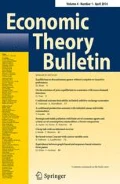Abstract
We construct a complete space of smooth strictly convex preferences defined over commodities and monetary transfers. Our model extends the classical one in that preferences are strictly monotone in monetary transfers, but need not be monotone in all commodities. We thereby provide a natural framework for performing genericity analyses in situations involving inventory costs or decisions under risk. The constructed space of preferences is contractible, which allows for a natural aggregation procedure in collective decision situations.





Similar content being viewed by others
Notes
To be fair, much of classical demand theory can be developed by relying on the weaker local-nonsatiation assumption; yet strict monotonicity appears to be the rule in applications. The implications of nonmonotone preferences for the existence and efficiency of competitive equilibria have been examined by Polemarchakis and Siconolfi (1993), among others. However, they take individual preferences as given and do not provide a framework for genericity analysis.
Notice, in that respect, that, when the state space is infinite, conducting a genericity analysis in the finite-dimensional space of portfolio choices is mathematically much simpler than doing so in the infinite-dimensional space of state-contingent consumption choices.
It should be noted that A4 does not follow from A1 if V is a proper subset of \(\mathbb {R}^{\ell +1}\); indeed, in this case, \(\succeq \) can be closed relative to \(V \times V\), though its upper contour sets are adherent to the boundary of V in \(\mathbb {R}^{\ell +1}\) and are thus not closed relative to \(\mathbb {R} ^{\ell +1}\).
Conversely, negative contributions to collective goods can, in the presence of altruistic concerns, come at a personal cost in the form of guilt or shame. For instance, if we interpret q in Fig. 2 as the individual’s contribution to a collective good, then, for any fixed level of t, he equally loses from contributing too little, \(q= q_1^- + \varepsilon \), as from contributing too much, \(q= q_1^+ - \varepsilon \). A4 implies that both situations involve prohibitive costs as \(\varepsilon >0\) converges to zero.
See Spanier (1966) for precise definitions of these terms.
References
Arrow, K.J.: Social Choice and Individual Values. Wiley, New York (1951)
Baigent, N.: Topological theories of social choice. In: Arrow, K., Sen, A., Suzumura, K. (eds.) Handbook of Social Choice and Welfare, pp. 301–334. Elsevier, Amsterdam (2011)
Becker, G.S.: Altruism in the family and selfishness in the market place. Economica 48(189), 1–15 (1981)
Chiappori, P.-A.: Rational household labor supply. Econometrica 56(1), 63–90 (1988)
Chiappori, P.-A.: Collective labor supply and welfare. J. Political Econ. 100(3), 437–467 (1992)
Chichilnisky, G.: Social choice and the topology of spaces of preferences. Adv. Math. 37(2), 165–176 (1980)
Chichilnisky, G., Heal, G.: Necessary and sufficient conditions for a resolution of the social choice paradox. J. Econ. Theory 31(1), 68–87 (1983)
Debreu, G.: Smooth preferences. Econometrica 40(4), 603–615 (1972)
Horvath, C.D.: On the topological social choice problem. Soc Choice Welf 18(2), 227–250 (2001)
Kannai, Y.: Continuity properties of the core of a market. Econometrica 38(6), 791–815 (1970)
Klee Jr., V.L.: Convex bodies and periodic homeomorphisms in Hilbert space. Trans. Am. Math. Soc. 74(1), 10–43 (1953)
Lauwers, L.: Topological social choice. Math. Soc. Sci. 40(1), 1–39 (2000)
Lauwers, L.: The topological approach to the aggregation of preferences. Soc. Choice Welf. 33(3), 449–476 (2009)
Mas-Colell, A.: The Theory of General Economic Equilibrium: A Differentiable Approach. Cambridge University Press, Cambridge (1985)
Mas-Colell, A., Whinston, M.D., Green, J.R.: Microeconomic Theory. Oxford University Press, Oxford (1995)
Polemarchakis, H.M., Siconolfi, P.: Competitive equilibria without free disposal or nonsatiation. J. Math. Econ. 22(1), 85–99 (1993)
Spanier, E.H.: Algebraic Topology. McGraw-Hill, New York (1966)
Varian, H.R.: Microeconomic Analysis, 3rd edn. W.W. Norton & Company Inc., New York (1992)
Wold, H., Juréen, L.: Demand Analysis: A Study in Econometrics. Wiley, New York (1953)
Author information
Authors and Affiliations
Corresponding author
Additional information
We thank the editor and two anonymous referees for very thoughtful and detailed comments. We also thank Michel Le Breton and Jérôme Renault for extremely valuable feedback.
Rights and permissions
About this article
Cite this article
Attar, A., Mariotti, T. & Salanié, F. On a class of smooth preferences. Econ Theory Bull 7, 37–57 (2019). https://doi.org/10.1007/s40505-018-0142-y
Received:
Accepted:
Published:
Issue Date:
DOI: https://doi.org/10.1007/s40505-018-0142-y



